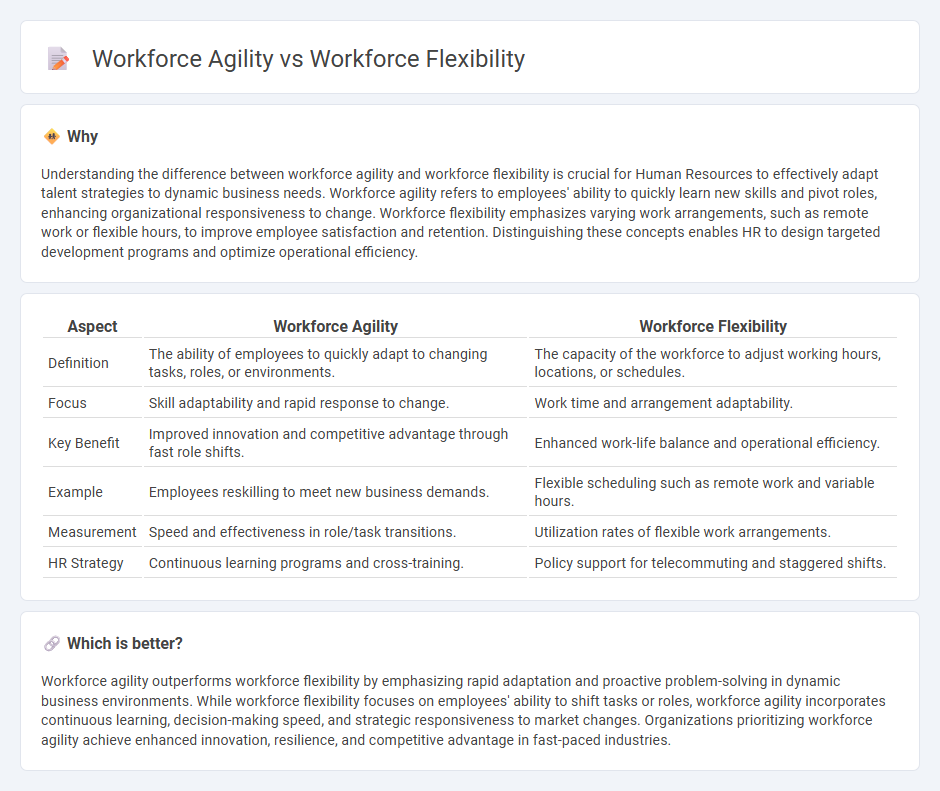
Workforce agility refers to an organization's ability to rapidly adapt to changing business conditions through skilled, cross-functional employees who can switch roles and responsibilities efficiently. Workforce flexibility emphasizes the capacity of employees to modify their work schedules, locations, or tasks to meet varying demands while maintaining productivity. Explore how balancing workforce agility and flexibility drives competitive advantage in dynamic market environments.
Why it is important
Understanding the difference between workforce agility and workforce flexibility is crucial for Human Resources to effectively adapt talent strategies to dynamic business needs. Workforce agility refers to employees' ability to quickly learn new skills and pivot roles, enhancing organizational responsiveness to change. Workforce flexibility emphasizes varying work arrangements, such as remote work or flexible hours, to improve employee satisfaction and retention. Distinguishing these concepts enables HR to design targeted development programs and optimize operational efficiency.
Comparison Table
| Aspect | Workforce Agility | Workforce Flexibility |
|---|---|---|
| Definition | The ability of employees to quickly adapt to changing tasks, roles, or environments. | The capacity of the workforce to adjust working hours, locations, or schedules. |
| Focus | Skill adaptability and rapid response to change. | Work time and arrangement adaptability. |
| Key Benefit | Improved innovation and competitive advantage through fast role shifts. | Enhanced work-life balance and operational efficiency. |
| Example | Employees reskilling to meet new business demands. | Flexible scheduling such as remote work and variable hours. |
| Measurement | Speed and effectiveness in role/task transitions. | Utilization rates of flexible work arrangements. |
| HR Strategy | Continuous learning programs and cross-training. | Policy support for telecommuting and staggered shifts. |
Which is better?
Workforce agility outperforms workforce flexibility by emphasizing rapid adaptation and proactive problem-solving in dynamic business environments. While workforce flexibility focuses on employees' ability to shift tasks or roles, workforce agility incorporates continuous learning, decision-making speed, and strategic responsiveness to market changes. Organizations prioritizing workforce agility achieve enhanced innovation, resilience, and competitive advantage in fast-paced industries.
Connection
Workforce agility and workforce flexibility are interconnected concepts essential for dynamic human resources management. Workforce agility focuses on the ability of employees to quickly adapt to changing business environments and roles, while workforce flexibility emphasizes varied work arrangements such as remote work, flexible hours, and job-sharing. Both strategies enhance organizational resilience by enabling rapid response to market shifts and promoting employee engagement, ultimately driving productivity and competitive advantage.
Key Terms
Adaptability
Workforce flexibility emphasizes the ability of employees to perform various tasks and roles as needed, often through cross-training and variable scheduling. Workforce agility, however, centers on how quickly and effectively a team can respond to changing market conditions, leveraging adaptability to innovate and solve problems under pressure. Explore strategies to enhance your organization's adaptability and drive both flexibility and agility for sustained success.
Cross-skilling
Workforce flexibility emphasizes the ability to adapt work hours and roles, while workforce agility centers on rapidly acquiring new skills and responding to dynamic business needs through cross-skilling. Cross-skilling enhances workforce agility by enabling employees to perform multiple functions, accelerating project turnaround and fostering innovation. Discover how cross-skilling can transform your organization's adaptability and competitive edge.
Rapid redeployment
Workforce flexibility emphasizes the ability to shift employees across various roles or schedules, while workforce agility prioritizes rapid redeployment to meet dynamic business needs and market changes swiftly. Agile organizations leverage cross-trained teams and real-time data to reassign talent effectively, minimizing downtime and enhancing productivity. Explore strategies to implement rapid redeployment and boost workforce agility for a competitive advantage.
Source and External Links
Three types of modern flexibility today's workers demand - This article discusses the importance of flexibility in meeting the diverse needs of modern workers, including work-life balance and personal health.
What Is Workplace Flexibility and Why Is It Important? - Workplace flexibility is vital for employees seeking a healthy work-life balance and for employers looking to increase employee satisfaction and productivity.
What Is Workplace Flexibility? Definitions & Examples from Top Workplaces - This resource explores different forms of workplace flexibility, highlighting its role in attracting and retaining talent in a rapidly changing work environment.
 dowidth.com
dowidth.com